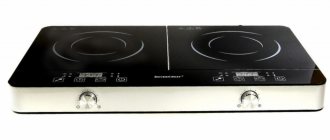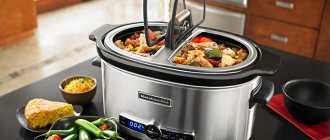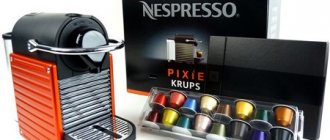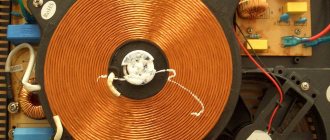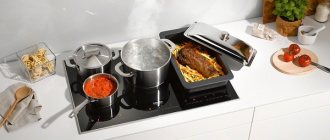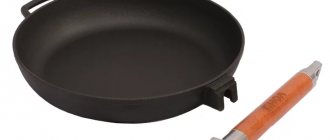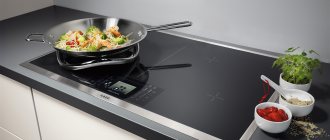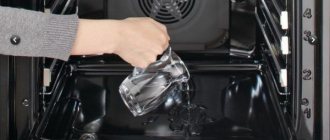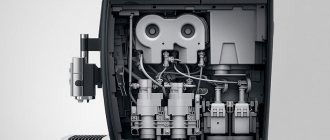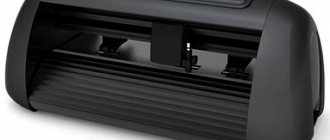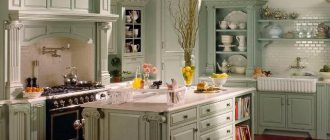When choosing a new stove, every buyer wonders which model is better to purchase: a simpler electric device with a glass-ceramic surface or an improved induction-type gadget.
Despite the fact that the designs are very similar in appearance and dimensions, each unit has its own positive and negative qualities , which can be decisive.
To choose the best option, it is worth comparing modern models of kitchen stoves, learning about their operating principles, features and key advantages.
Page navigation:
Operating principle and features of glass-ceramic plates
A glass-ceramic stove is one of the types of electrical equipment intended for cooking, the development of which uses a glass-ceramic coating.
Unlike conventional electric devices, glass-ceramic devices have a perfectly smooth mirror surface, which has increased strength and the ability to withstand impacts of any force .
The operating principle of such a device is similar to the mechanism of operation of a classic stove with cast iron burners.
The main working elements of the stove are heated using a tubular electric heater.
After this, heat passes from it through the glass-ceramic surface, heating the dishes placed on the surface.
Additionally, glass-ceramic appliances are equipped with halogen burners with heat-producing lamps, which are heated by a fused strip.
Experts call the main features
- slow heating and fast cooling;
- heating the dishes, not the surrounding area;
- preparing various dishes in dishes of various shapes;
- variable heating zone;
- presence of automatic boiling;
- kitchen interior transformation.
Operating principle and features of induction cookers
Important! Unlike glass-ceramic models, the operating principle of induction devices is based on the action of pre-installed induction coils that create a powerful high-frequency magnetic field under the influence of electricity.
Thus, during the operation of the coils located under the hob surface, the cookware is heated , in which a certain amount of ferromagnetic particles is present.
The hob itself remains cold.
Having chosen induction equipment, it is important to remember that for cooking you will have to purchase special cookware or an adapter that allows you to quickly and evenly heat the kitchen utensils.
Among the features of induction equipment , the following points can be highlighted:
- heating due to coils creating electromagnetic radiation;
- the surface can only be used when there is a utensil installed on it;
- instant change in temperature conditions to the desired level;
- absence of unpleasant odors in the kitchen;
- automation of most processes;
- high energy efficiency class.
Advantages of induction cookers
The induction heating method is considered quite new. Under the working surface there is an electromagnetic coil, thanks to which the food is heated, and not the dishes themselves. The table top of this stove is made of glass ceramics.
Cooking on an induction hob takes less time
The advantages of induction cookers include:
- economical energy consumption;
- the fastest possible heating of the burners;
- the working surface itself does not heat up;
- after cooking, the dishes remain slightly warm;
- up to 20 operating modes;
- instant change in temperature from 60 to 1 degree;
- automatic shutdown in the absence of dishes or boiling;
- blocking the entire panel when the wrong mode is turned on;
- different functionality in more expensive models.
Attention! A spoon or ladle accidentally left on the hob will not cause the burner to turn on.
Advantages and disadvantages of models
It is worth noting! Glass ceramic hobs have gained popularity due to the following advantages:
- ability to withstand heat up to 600 degrees;
- independent adjustment and selection of the optimal temperature for preparing a particular dish;
- many options for convenient use, including a timer and several cooking modes;
- the possibility of using a variety of cookware that does not have ferromagnetic properties;
- affordable cost and no need for special maintenance.
The main disadvantage of electric glass-ceramic stoves is the need for thorough but gentle cleaning using special tools and detergents with a certain chemical composition.
Otherwise, micro-scratches will begin to appear on the hob.
Keep in mind! Modern induction models are also famous for their many advantages:
- high speed of cooking due to rapid heating of the dishes, and not the entire hob;
- a reliable security system, which includes the function of automatically turning the device on and off when installing dishes and removing them from the electric burner;
- easy cleaning of the surface from dirt - just wipe the areas with a soft sponge, since fat and food do not burn;
- instant temperature change accurate to the degree using an intuitive control panel;
- extensive functionality that significantly simplifies the operation process and saves time;
- economical energy consumption.
the need to select suitable cookware and the high cost of equipment as the disadvantages of induction cookers
In addition, difficulties may arise with the installation of the device - it cannot be placed next to a washing machine or dishwasher, since such proximity can extremely negatively affect the operation of other units.
Induction hob: advantages and disadvantages
Induction panels are relatively new on the market, and consumers do not always understand their features. This is especially important for making the right choice. Let's look at the advantages and disadvantages.
Advantages:
- High efficiency.
- Heating begins instantly after turning on the stove.
- After turning off the stove, the burners remain cold.
- The food doesn't burn because the burners don't heat up - the pan does. Therefore, the hob is easy and quick to clean.
- You won't get burned on the burner when you remove the pan from it.
- Many functions: child protection, auto shut-off when removing heated dishes, etc.
- Precise adjustment of heating temperature and quick response to its changes. There is no inertia as in heating elements.
Flaws:
- You need appropriate cookware made from soft magnetic materials. In other words, made from stainless steel and its alloys, cast iron cookware is just as suitable as enameled cookware - the main requirement is a smooth and thick bottom without chips or dents. Therefore, most of the old dishes will remain in service. To check if the dish is suitable, simply hold a magnet to its bottom; if it is magnetic, it is suitable. However, there are special adapters - metal pancakes, with or without a handle, on which any utensil can be placed.
- The cost of this type is higher than that of slabs with heating elements.
- The magnetic field negatively affects surrounding household appliances and humans. However, induction panel manufacturers claim that this factor is minimized in their products.
- The device has a built-in fan for cooling. In cheap models it is quite noisy and this can be annoying during operation. In premium models, manufacturers choose technical solutions with minimal noise levels. During operation, the noise will increase, this can be solved by repairing or replacing the fan.
Comparative characteristics and differences
In order not to make a mistake in choosing a device, you need to pay special attention to the main technical parameters and differences between glass-ceramic and induction models.
The most convenient way is to make a comparison and see what the difference is using a small table.
| Characteristics | Glass ceramic hob | Induction cooker |
| Heating rate | The installed cookware heats up within a couple of minutes | The pan heats up in just a few seconds |
| Dishes | Possibility of using dishes of completely different shapes without mechanical damage | Using exclusively dishes with ferromagnetic properties and a perfectly smooth bottom |
| Control | Mainly mechanical activation and regulation, but also sensory | Automatic switching on and convenient touch control |
| Safety | There is a small chance of getting burned, but the unit is safer than gas counterparts | The device is absolutely safe for small children and animals, but is not recommended for use by people with pacemakers |
| Economical | Increased energy consumption | Low power consumption |
| Cleansing | Regular cleaning is carried out without much difficulty, but complex dirt and old stains are less easily removed | Dirt can be easily removed with a soft sponge and non-abrasive detergent |
| Noise | Working with a reduced audio level | Possible low humming noise |
| Efficiency | 60% | 90% |
Advantages and disadvantages of an induction cooker
The advantages of this option include:
- High performance with low electricity consumption.
- Modern induction models have a high efficiency (more than 90%).
- Fast heating and cooling of burners.
- Absolute safety of use. It is impossible to get burned if you come into contact with an induction hob.
- Independence from voltage surges.
- The ability to speed up the heating of one burner at the expense of another.
- Availability of automatic on and off function. When you place the cookware on the surface, the stove will turn on, and when you remove it, it will turn off.
- When the induction hob is operating, the air does not heat up, and therefore there is no need for ventilation.
- Ease of use.
- Attractive appearance.
- A harmonious combination with any interior style.
The disadvantages are:
- High price.
- The need to purchase special utensils, the cost of which is also quite high.
- Increased loads on electrical wiring.
- Impact on some items - bank cards, flash drives, etc.
- Difficulty choosing a location for installation. When placing the hob, various technical nuances must be taken into account.
Which model is better to choose?
If you want to purchase budget equipment that will be easy and convenient to work with, experts advise choosing a glass-ceramic model.
You should know! The device has a sufficient number of working programs and can fully satisfy the needs of experienced users.
However, if the buyer wants to save time and effort, it is better to purchase an induction cooker .
The unit will cost more, but thanks to automatic temperature control of the burners and an impressive list of useful options, the user will enjoy the work.
TOP 3 best glass-ceramic stoves
#1
Gorenje EC 5121 WG-B
An ultra-modern device that lovers of delicious homemade dishes cannot do without.
A glass-ceramic electric stove with a spacious oven, which the user does not have to manually clean from dirt.
To remove drips from the unit, you will need to press a button - the interior will be automatically cleaned using hot steam.
A large work area with conveniently located burners will allow you to prepare a large number of dishes without spending a lot of time.
Specifications:
- work surface material – glass ceramics;
- rated power consumption – 8.6 kW;
- control – mechanical;
- switches – rotary;
- dimensions – 50x60x85 cm.
Advantages
- the presence of a spacious drawer for dishes;
- basic control panel;
- laconic and elegant design;
- the presence of an electric grill;
- Instant heating of dishes.
Flaws
- the model does not have a lid;
- the cost is slightly higher than similar models;
- Difficulties may arise when connecting the equipment.
#2
Hansa FCCW53000
A premium model that stands out for its ease of use and high level of security.
An attractive electric stove that successfully combines modern design, high power and durability.
The appliance is equipped with residual heat indicators, a spacious drawer for storing utensils and 4 smooth burners that are easy to clean.
For comfortable and fast cooking, the unit is equipped with ergonomic rotary switches.
Specifications:
- work surface material – glass ceramics;
- rated power consumption – 7.8 kW;
- control – mechanical;
- switches – rotary;
- dimensions – 50x60x85 cm.
Advantages
- high level of security;
- ease of cleansing;
- a large number of electric burners;
- affordable price;
- silent operation.
Flaws
- The power cord must be purchased separately;
- The device does not have a display;
- no countdown timer.
#3
Electrolux EKC 952903 X
High-power electrical unit aimed at long-term and uninterrupted operation.
An impressive full-size stove with an electric grill, a small display and a timer, equipped with four electric burners.
Despite its size, the design does not look bulky at all and perfectly complements any kitchen interior.
For convenient control over the process of preparing various dishes, the electrical device is supplemented with interior lighting.
Specifications:
- work surface material – glass ceramics;
- rated power consumption – 8.31 kW;
- control – mechanical;
- switches – rotary;
- dimensions – 50x60x85 cm.
Advantages
- the presence of an innovative dual-circuit burner;
- convenient rotary switches;
- work at low sound levels;
- rapid heating of installed dishes and their contents;
- saving kitchen space.
Flaws
- slight chemical smell when first used;
- inability to lock the door in a certain position;
- the design requires careful and delicate cleaning.
Glass ceramic plates
So, we continue to answer the question of which is better: an induction or glass-ceramic hob. Let's move on to analyzing the pros and cons of the second. But before that I would like to make one remark. In principle, all hobs (of these two types) are covered with glass ceramics. It’s just that ordinary people, at their unprofessional level, made such a division, that is, into an induction cooker or glass ceramics.
All stoves of this type are divided according to the type of heating elements installed in them. They can be tubular, tape, plate, spiral and so on. But at the heart of all elements is a filament.
And since this type of stove has been used in kitchens for a long time, the reviews about them accurately determine their advantages and disadvantages.
- Such slabs can withstand quite serious temperatures - up to +600C.
- Energy consumption is not optimal and efficient for all models.
- If pancake-type burners or ordinary heating elements are used on the panels, then their heating plane cools down very quickly.
- Their safety is practically no different from induction cookers.
- Low relative price.
- Manufacturers offer additional options in each model.
A very important point regarding stoves with shadow heaters. For them, it is better to use dishes with a thick and smooth bottom. In this case, it is necessary to select it exactly to the size of the burner. If, for example, the diameter of the cookware is smaller than the area where it is installed, then the panel itself will begin to overheat, which will soon cause it to fail.
Read also: Requirements for connecting the hob to the electrical network
And the last thing is care, which will put an end to the debate about which is better - induction or glass-ceramic hobs. Whatever you say, the high surface temperature is the place where everything will burn. So you will have to equip yourself with sponges and detergents to clean the surface of the stove. And the housewives really don’t like this. And although you can buy special cleaning gels on the market made specifically for glass-ceramic products, cleaning is still not the most pleasant process.
TOP 3 best induction cookers
#1
Beko FSM 69300 GXT
Durable and safe to use design, ideal for installation in a large kitchen.
Freestanding four-burner induction hob with 8 operating modes, three-glazed oven door and an easy-to-clean enamel interior.
The design is complemented by an electric grill, residual heat indicators to determine the surface temperature and a special program for uniform baking of pieces.
Specifications:
- work surface material – glass ceramics;
- rated power consumption – 9.6 kW;
- control – electronic;
- switches – recessed;
- Dimensions – 60x60x85 cm.
Advantages
- bright lighting of the interior space;
- large oven volume;
- opening the door without effort;
- pleasant and stylish appearance;
- optimal number of heating zones.
Flaws
- light specific smell;
- noisy operation of electric burners at maximum power;
- inability to lock the door.
#2
GEFEST 6570-04
An improved gadget that will become an excellent kitchen assistant in creating real culinary masterpieces.
Induction hob with four powerful heating zones, equipped with residual heat indicators for safe use and avoid the possibility of getting burned.
The device is equipped with an automatic safety shutdown function and locks the electronic control panel from young children.
There is a drawer for utensils.
Specifications:
- work surface material – glass ceramics;
- rated power consumption – 10.3 kW;
- control – electronic;
- switches – touch;
- Dimensions – 60x60x85 cm.
Advantages
- accelerated heating of dishes and contents;
- the presence of removable wire guides;
- double illumination of the interior space;
- adjustable feet;
- electric spit.
Flaws
- the hob surface is susceptible to scratches;
- the built-in clock does not work in sleep mode;
- The package does not include a plug.
#3
Electrolux EKI 954901 X
An easy-to-use device equipped with all the functions and programs necessary for comfortable work.
Electric stove with induction hob and powerful oven, equipped with a cooling fan and bright lighting.
For compact storage of kitchen utensils, the device is equipped with a spacious utility compartment.
The uniform distribution of hot air throughout the chamber is ensured by the presence of a convector.
Specifications:
- work surface material – glass ceramics;
- rated power consumption – 9.9 kW;
- control – mechanical;
- switches – rotary;
- dimensions – 50x60x85 cm.
Advantages
- instant response to user commands;
- economical energy consumption;
- uniform distribution of hot air;
- cooking with steam function;
- interesting design.
Flaws
- high price;
- noisy operation of the cooling fan;
- the appearance of scratches on the cooking surface.
Features of an induction cooker
Let's consider what is the specificity of an induction cooker - a unit that is considered the most convenient to use. The features of this device are:
- Economical. This model consumes a minimum of electrical energy.
- Functionality. There are more than two dozen different operating modes.
- High performance. The efficiency of these devices is 90%.
- Saving the housewife's time. It has the ability to quickly change the cooking temperature. Can turn on and off automatically.
- Comfort of use. Provided with appropriate protective functions and other various options. For example, it is possible to automatically turn off when boiling, when there is no utensils, lock the control panel from children, or during operation when the user has set the required mode.
- Easy to use. The device requires only minimal human supervision.
- Ease of maintenance and care. The unit panel does not require any special care. She is not afraid of runaway soup or milk.
- Safety. It is impossible to get burned on the surface of the burners.
It is also worth noting that in induction cookers, heating comes only from the bottom of the cookware.
conclusions
When choosing between an electric glass-ceramic stove and an advanced induction-type device, you need to remember the following nuances:
- glass-ceramic units are distinguished by their low price, intuitive controls and operation with a low sound power level ;
- induction models are safer to use and easier to maintain, they have a wide range of functionality, but are more expensive ;
- the main selection criteria are parameters such as power consumption, type of control and equipment dimensions ;
- Particular attention should be paid to the security system, which will allow you to use the electrical appliance without fear.
